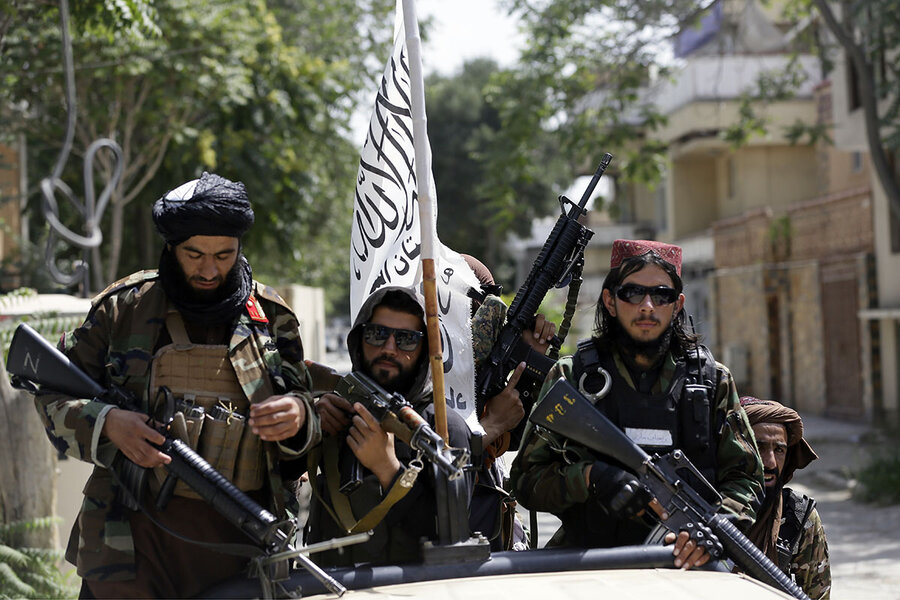How the Taliban won: They leveraged Afghan history and culture
Loading...
The Taliban’s routing of Afghanistan’s national security forces – which saw more than half of the country’s provincial capitals topple like dominoes in just one week – shocked much of the world.
Yet the story of how the Taliban gained the advantage over a large 350,000-strong Afghan national security force, trained and equipped by the United States at a cost of about $85 billion, starts with Afghan history and culture.
Why We Wrote This
The Taliban’s homegrown strategy, years before the U.S. departed, took advantage of intimidation, official corruption, and extensive networking to roll up the Afghan countryside. Part 1 of two.
“They used age-old Afghan traditions, as was the case when they came to power the first time [in 1996],” says Doug London, former CIA counterterrorism chief for South and Southwest Asia. “It wasn’t through a series of military conquests. The Taliban leveraged negotiations and bribery with local and provincial officials.”
The Taliban’s sweeping, concluding military offensive as the U.S. withdrew was just the final push of a dogged, homegrown insurgency that was years in the making. Their long-term strategy was grounded in the countryside, utilizing local relationships to win territory, guns, and recruits – valley by valley – eventually allowing the militants to encircle and cut off the cities. And they deftly waged psychological warfare on social media to spread a narrative of their inevitable victory, demoralizing Afghan government forces.
For 50 days, Abdul Hanif and his small Afghan paramilitary force had been battling Taliban fighters putting a stranglehold on the city of Asadabad, the capital of Afghanistan’s eastern Kunar province.
The Taliban were gaining ground, and Mr. Hanif, a tall, lanky provincial official and longtime Taliban nemesis, was rushing from one front to the other urging the Afghan National Army to fight.
“We are fighting on one side, and on the other side the ANA just lets the Taliban come through, and gives them their own weapons and ammo, and even their armored trucks,” he said in a phone interview, his words sometimes punctuated by gunfire.
Why We Wrote This
The Taliban’s homegrown strategy, years before the U.S. departed, took advantage of intimidation, official corruption, and extensive networking to roll up the Afghan countryside. Part 1 of two.
“It’s been really tough to hold because we are trying to convince the ANA to fight,” he said, asking that his real name be withheld for his protection. Running low on ammunition and other supplies, he estimated they could fend off the enemy for three or four more days.
As it turned out, Asadabad fell to the militant group the next day, Saturday. It was one of the last major cities to be captured by the insurgents before they rolled into Kabul and took over Afghanistan Sunday.
The Taliban’s routing of Afghanistan’s national security forces – which saw Asadabad and more than half of the country’s provincial capitals topple like dominoes in just one week – shocked much of the world.
Yet the story of how the Taliban gained the advantage over a large, 300,000-strong Afghan national security force – trained and equipped by the United States at a cost of about $85 billion – starts with Afghan history and culture.
“They used age-old Afghan traditions, as was the case when they came to power the first time [in 1996],” says Douglas London, former CIA counterterrorism chief for South and Southwest Asia. “It wasn’t through a series of military conquests. The Taliban leveraged negotiations and bribery with local and provincial officials.”
Gains, valley by valley
The Taliban’s sweeping, concluding military offensive was just the final push of a dogged, homegrown insurgency that was years in the making.
“Contrary to popular belief, this was the ... quick end to a campaign they had been waging for quite a long time,” says Jonathan Schroden, director of the Countering Threats and Challenges Program at CNA, a research and analysis organization in Arlington, Virginia. “Since 2015, when the U.S. [troop] surge ended and the U.S. transitioned to the advise-and-assist model, the Taliban have been steadily encroaching.”
The Taliban’s long-term strategy was grounded in the countryside. It leveraged local relationships to win territory, guns, and recruits – valley by valley – eventually allowing the militants to encircle and cut off the cities. It took advantage of shifting political calculations among Afghan warlords and commanders triggered by the U.S. military withdrawal. And it deftly waged psychological warfare on social media to spread a narrative of their inevitable victory, demoralizing Afghan government forces.
The Taliban used “an isolation strategy that had an extremely adroit information component to it,” says Dr. Schroden.
In sharp contrast, the Afghan government of President Ashraf Ghani focused on concentrating power and building national forces to defend large, populous cities – a strategy that runs counter to Afghanistan’s history of decentralization, he says. In a January assessment, he warned that the Taliban would have “a slight military advantage” over Afghan security forces if the U.S. withdrew all its forces.
Home turf
The Taliban projected confidence as they encircled the dusty, rugged town of Asadabad, nestled in the Hindu Kush mountains about 8 miles from the border with Pakistan. They were laying siege to the capital with thousands of men, including fighters from allied extremist groups such as Al Qaeda, and the Tehreek-e-Taliban Pakistan, or Pakistani Taliban, Mr. Hanif said.
“We are left with only about 300 people who are fighting,” said Mr. Hanif of his paramilitary force. Some had been redirected to bolster Herat, the large oasis city in western Afghanistan, he explained. About 900 men from local tribal militias had stood up, but between them they only had 80 AK-47 rifles.
“I don’t have weapons for them,” he said, exasperated. “It’s hard for the central government to do resupply because the fight is going on all across the country,” he added. Two of his soldiers were killed by the Taliban the day before, and two lay wounded. “I don’t know what’s going to happen to them,” he said.
Lopsided battles like the one at Asadabad played out in cities across the country, with elite units such as the Afghan special forces being among the few to put up a fight.
And the Taliban had the advantage of fighting on their home turf.
Most Taliban come from rural villages, where they are members of the same tribal clans and subclans as government officials and military commanders – making them relatives or neighbors. Starting at the district level, they created shadow governments and militaries in every province. Then they offered deals to switch sides.
“About a year ago, the Taliban started reaching out to lower-level government troops and fighters, offering money for their weapons and to abandon their posts. And then they ratcheted up the process to reach more senior provincial leaders,” says Mr. London.
The Taliban’s control over rural areas, which had grown steadily since the U.S. military handed over security to Afghan forces in 2014, rose dramatically as U.S. forces began their final pullout this summer. In one month, from June to July, the number of districts under Taliban control doubled from 104 to 216, according to tracking by the Long War Journal.
U.S. departure
Critically, the departure of the remaining 2,500 U.S. troops and U.S. military air power (before the current evacuation mission) deprived the Afghan army of a powerful, quick reaction capability against the Taliban. This freed Taliban forces to move rapidly to seize large swaths of territory and road networks and posts along the Iran, Tajikistan, and Pakistan borders. All of this left Afghan army units increasingly surrounded, isolated, and vulnerable, as they could only be resupplied by air, severely overtaxing the Afghan air force.
The Taliban then began attacking cities, first in the north. Contrary to the popular narrative, initially some Afghan units did stand and fight, says Dr. Schroden. But, he says, “they very quickly ran out of ammunition, food, water. They called for airstrikes, and none would come. They called for reinforcements, and none would come.”
Long-standing problems with corrupt commanders and “ghost soldiers” – fighters who existed only on paper, in order to line the commanders’ pockets – as well as the lack of pay and the incongruence of the model of a central, integrated military in a country that functions on ethnic and tribal lines, had weakened allegiances to the national army.
“If you know that help is not coming, and you’re not totally invested in the government with all your heart and soul, when the fight finally comes to your doorstep, why would you stand and fight?” Dr. Schroden says. “That just became an avalanche of desertion.”
Displaying social media savvy, the Taliban amplified these events by texting images and video of their fighters walking around army bases and driving Humvees. The posts went viral on social media, advancing the narrative that a Taliban victory was inevitable.
The psychological impact of this message of the Taliban’s imminent return to power ran deep, especially as all Afghans knew the Taliban had never left.
The Afghan government and Pentagon planners had counted on the Afghan army to defend hardened positions – a “ring of steel” around the cities – to force the Taliban to mass in concentrations that would make them vulnerable to bombing from above. But morale broke among much of the force before that ever happened.
Many elite forces, including Afghan special forces and paramilitary units such as that under Mr. Hanif, did fight until the last possible moment. Unlike the regular army, these units were organized largely along community and tribal lines, with elders vetting new recruits.
“They have kind of an obligation to one another,” says Mr. London, author of “The Recruiter,” a book about the CIA’s post-2001 transformation. “Given their reputation after years of bleeding the Taliban ... such troops realized that surrender was less likely to be an option and amnesty highly unlikely,” he says.
Mr. Hanif had to fight his way out of Kunar and is on the run. “We will fight until our last breath,” he said in his last phone call.









